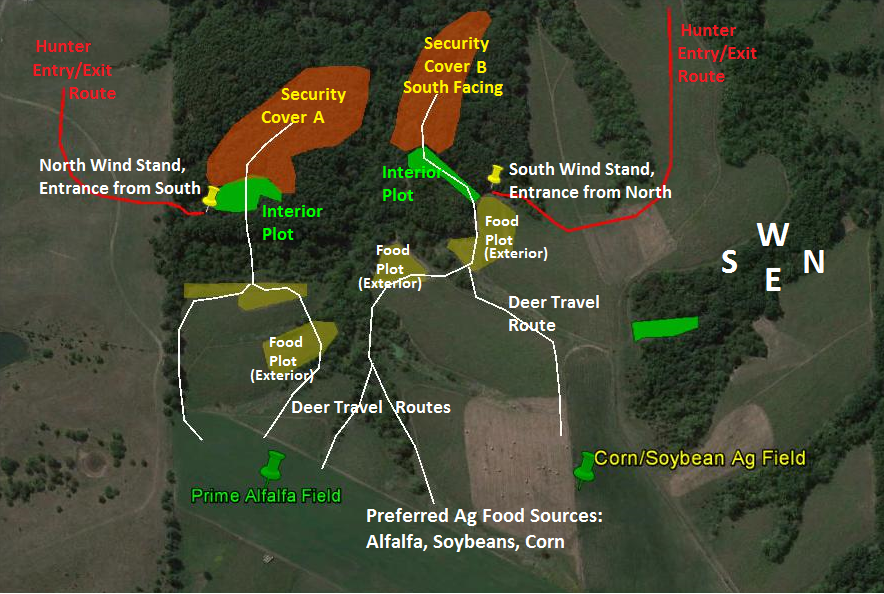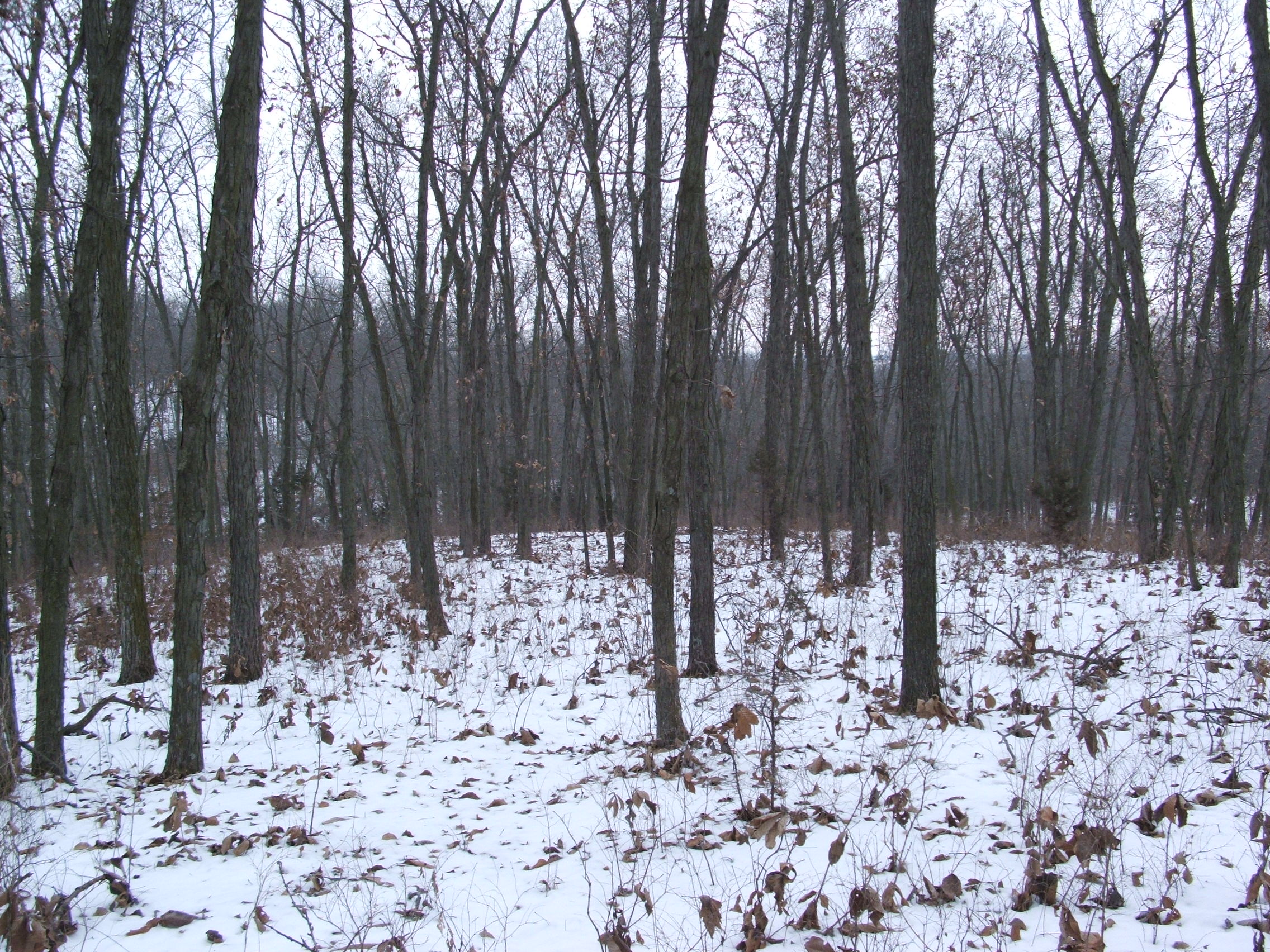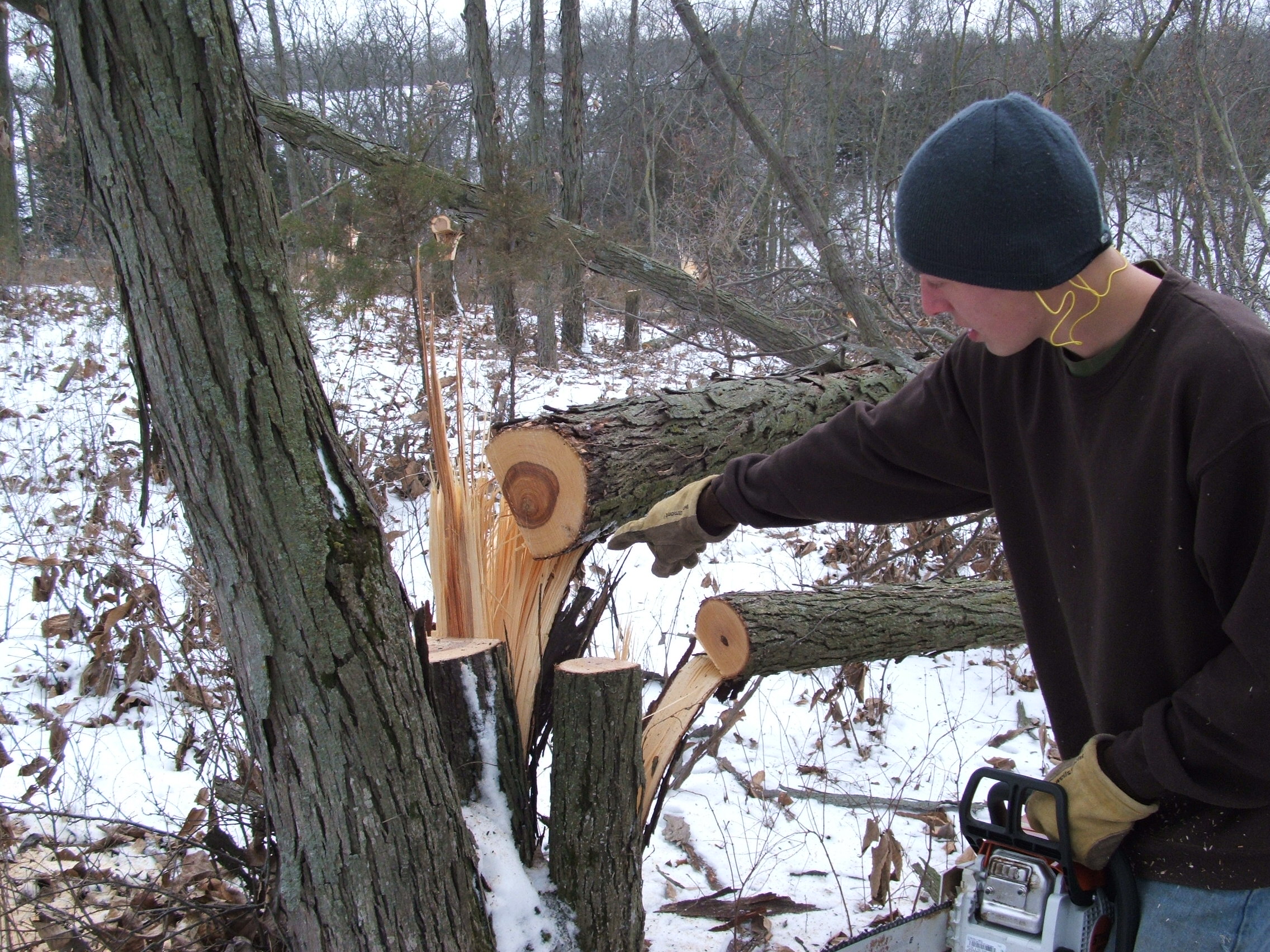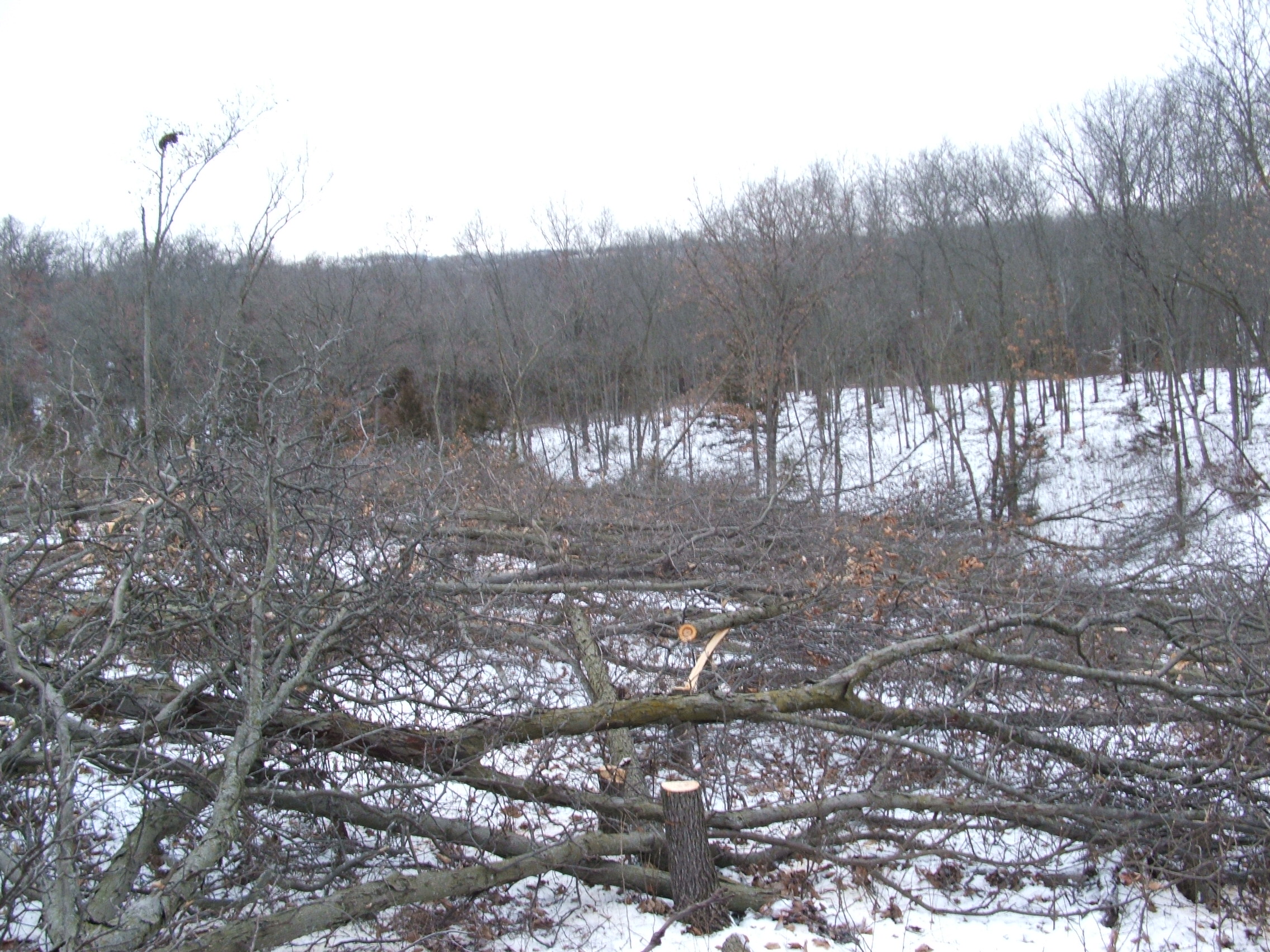March 2015 Creating Security Cover
Creating man-made areas of security cover is arguably the best way to increase the amount of deer that call your property home. It also creates an environment for deer to spend more time on your property instead of just passing through it. It increases the carrying capacity of the land…meaning more deer will be able to live and thrive per acre. Good security cover will mean deer will spend more time on your property during all seasons including late fall and winter. But, creating security cover should be about more than just having more deer. The physical act of cutting down trees or planting different species of trees or shrubs for the sake of creating thickets of cover is actually pretty straight forward. In the grand scheme of things, when creating great habitat for deer to bed and feel comfortable, you should always start at the end.
The Ending Comes First
I’ll get to the hands on methods of creating bedding thickets and security cover in a bit. But like most ideas and tactics I’ve applied in the past…and learned from, planning makes for the highest return on your time and money. What’s to plan? Well, let’s start at the end. When all the work is done, and it is now three years down the road you can expect that deer will spend more time congregating and bedding in the area you created for them a short time ago. If done correctly, deer will now bed in the areas you created for them. Wouldn’t it be nice if you could force all the deer in your area to bed where you want them to? It would make hunting different wind directions easier. It would surely make it more easily predictable what route they would take when traveling from bedding to feeding and back again wouldn’t it? Well, you can’t force deer to do anything. But by creating security cover…or in other words creating the preferred bedding areas where we want them we can help to manipulate deer movement patterns. And manipulate the patterns in an effort to give us the advantage.
My goal is to hunt deer without letting them know I’m hunting them. This means getting to and from my ambush sites without bumping deer, and staying undetectable while on stand. In the February article I talked about making interior food plots. Now in this article I’m talking about creating man-made security cover. When done correctly, you can create areas of congregation and rutting behavior (interior plots) and areas of bedding cover (man-made bedding areas) in conjunction with one another to manipulate deer into travel patterns. Travels patterns that you can exploit!!! It’s rather easy to establish food plots and create thick areas of bedding cover…but, creating them in ways that makes our hunting easier should be the goal. After all, having a picture perfect food plot or bedding area does us little good if made in a way that doesn’t ultimately help us hunt the deer we are after.

This graphic illustrates two examples of creating security cover in conjunction with interior plots. The larger section of timber to the west acts as the area that can be exploited in creating great security cover and establishing an interior plot or two. Several exterior food plots have been planted at the edges of the timber. A draw with many fingers acts as a travel corridor for deer leaving the bigger timber and food plots and making their destination to the larger Ag fields to the east planted in preferred food sources like alfalfa, corn, and soybeans. The deer travel pattern is to leave the security cover in the evening making their way into the interior plots to snack on green food sources like clover or rye and to stage up rutting (scraping and rubbing) in or near the interior plots. As dusk approaches, the deer travel outward toward the exterior food plots where they hold up and spend more time feeding on the food plots. As the sun finally dips below the tree line the deer make their way into the preferred Ag food sources for their evening feeding pattern. The flow of deer is in a west to east pattern. A reverse flow can be witnessed in the morning as deer head back to bed in the man-made security cover areas in an east to west pattern.
By creating the security cover adjacent to the interior plots, most deer will leave their beds and travel in a pattern that is most predictably past our predetermined stand sites. Let’s first look at example A. This cover was created just west of an interior food plot. Deer leaving their beds can be seen traveling to the east making their way to the interior plot. After eating and rutting they will exit to the east out to the exterior food plots and Ag fields. By placing a stand on the south side of the interior plot, a hunter can take advantage of deer moving west to east when the wind is out of the north. Entering the stand from the south the deer will not smell you on your way into your stand or detect you while on stand. The deer will mostly be out in front of the hunter on the upwind side of the stand moving at a cross wind. At quitting time, most if not all deer will have already worked past your stand heading toward the Ag fields…this allows you to get down and sneak out to the south without ever being busted.
Example B is the same but the opposite. Deer leaving security cover B will travel from west to east and stop by the interior plot to snack and rut exiting to the east to make their way to the food plots and Ag fields. The travel pattern is mostly a west to east pattern. By hanging the stand on the north side of the interior plot, the hunter can enter and exit the stand from the north hunting the spot with a south wind. This way, the deer are out in front on the hunter on the upwind side moving in a crosswind fashion. Deer in their beds cannot smell the hunter…deer around the interior plot cannot smell the hunter…and deer exiting and traveling to the Ag fields also cannot smell the hunter. By quitting time, most if not all deer have moved on and the hunter can safely without detection sneak out back to the north without being detected. In both examples A and B the scenario played out to have two great set ups for a north or south wind because of deer travel patterns moving mostly west to east and back. This tactic can obviously be used to set up west and east wind ambush sites by creating the same type of scenario only with a north to south or south to north deer travel pattern.
You can see by using this method of creating man-made security cover in conjunction with interior plots, getting to and from the stands without bumping deer is pretty easy. Keeping the deer on your upwind side is also more predictable. This also alleviates a big problem with hunting field edge stand sites. Let me explain. I often get asked what wind you should hunt an exterior food plot or Ag field with. The problem is, when hanging a stand on a field edge do you hunt with your wind blowing out to the field or into the woods. With the wind blowing out, deer won’t smell you in the timber but once on the food source can and will get down wind and bust you. Deer coming out early will eventually get down wind and blow. Or, do you hunt with the wind blowing into the woods? In this case deer in the timber downwind of you will bust you and never come out, but deer that do make it into the field are now on your upwind side. The answer? NEITHER! In both cases, you are allowing and even accepting that on any given hunt as much as half of the deer feeding at your location are going to bust you. By creating a scenario where the deer move past you on a crosswind, they never get down wind.
As I’ve already pointed out, the location of the thicket you create can be the most important element. However, not all hunters have a piece of timber large enough to take advantage of those tactics. In any event, creating security cover has one of the largest returns on your investment. It is for the most part very inexpensive to accomplish and is fairly easy to do. If you have the ability to plan out a setup like example A or B, take the time to do so and not only reap the benefits of better habitat, but also of creating a killer stand location.
Methods of Creating Man-Made Security Cover
There are basically two methods I use to create cover. The first, is to plant species of trees, shrubs, or native grasses that are preferred bedding for deer. This can actually get expensive and can require a great deal of man power and tools to make possible. In most cases, planting trees and shrubs on open ground with today’s income potential with farm land is probably not a great idea. Unless of course you can get into a conservation program that makes up all or a part of that lost farm income. Planting native grasses under the umbrella of a good conservation program might be a better option if turning open ground into bedding habitat. The method of planting woody plants or native grasses is really a whole article by itself.
I like to concentrate my habitat improvements when creating bedding cover on the timbered areas. Why? Because undeveloped timber with very little underbrush or vegetation is wasted land. Very little food is available and open mature timber offers very little in the way of bedding. Managing timber for deer habitat can actually help a forest improve its timber value as well.

A mature group of trees like these hickory offer very little in the way of food or shelter for deer.
Once I have determine the location of where I want to create my thicket, all I need to do to accomplish the task is to start cutting down target trees. Trees of very little timber value like box elder are the obvious choices to cut. On my farm, I also target shagbark hickory and locust. I’ll even consider taking the chain saw to an oak or walnut if they are bending badly, looked diseased, or are otherwise obviously not going to be of any value someday. Most of my man-made thickets are about 1-5 acres in size. If I have a 40 acre block of timber for example I will plan out maybe 3-6 different small thickets spaced apart by 5 years or so. This way, every 5 years I create new cover and new habitat while the last one I created starts to grow up and mature. If you are cutting adjacent to an interior plot, you can make smaller pockets so that the tactic lasts longer. It seems to me that years 1-7 or so are the most preferred by the local deer herd for bedding. If the goal is to cut down trash trees like box elder or low value non mast bearing trees like hickory while opening up the forest to promote regeneration of oak or walnut, you might want to try hinge cutting the trees.

Here my son Forest is using the Stihl MS170 to make this thicket. No gimmicks here! Just planning and work. Hinge cutting these hickories will allow them to stay alive for a year or so giving the new trees time to establish.
Hinge cutting allows a tree like hickory to live a year or so before dying. The vegetation from the hinge cut tree will actually protect new oak and walnut saplings while they are young and trying to establish. Hinge cutting also provides cover and food for the deer before regrowth of other more desirable trees starts. If you want to make sure to kill the tree you cut down, treating the stump with a chemical like Tordon RTU is also a good choice for prolific “stump growers” like box elder. And lastly, if you are not sure which trees to cut, you might want to try soliciting help from a forester. The concept is simple…by cutting down all or a high percentage of trees in a small area you will open up the forest floor to light promoting vigorous regrowth of trees and brush…perfect deer habitat!
This approximately 3 acre piece of open ground was primarily mature and semi-mature hickory. By cutting down most of the trees, we are promoting vigorous regrowth. This cutting happens to be adjacent to an interior plot and is on a ridge side facing south. Don’t cut out mast producing trees like oak or young preferred trees like oak or walnut.
Creating man-made security cover has a very high return on investment. A $200 chain saw and a day’s work can get you well on your way to creating great habitat. Creating the thickets in conjunction with interior food plots and your investment can really pay off with some great hunting opportunities. No gimmicks here! Planning before you ever cut down a tree will help you for years in your hunting set ups. This March, I will be cutting down some more hickory surrounding an interior food plot I have established. Only a half-acre in size to compliment the three acres I cut down in 2012.
In April’s issue, I will be going over planning this year’s food plot choices. It will be a guide to why I choose the plant species I do and why they have worked the best for me. April’s issue is about planning not necessarily doing…this way you can buy your seed and line up your implements for late April and May. In the May issue I will be going over spring planted food plots and planting techniques.

